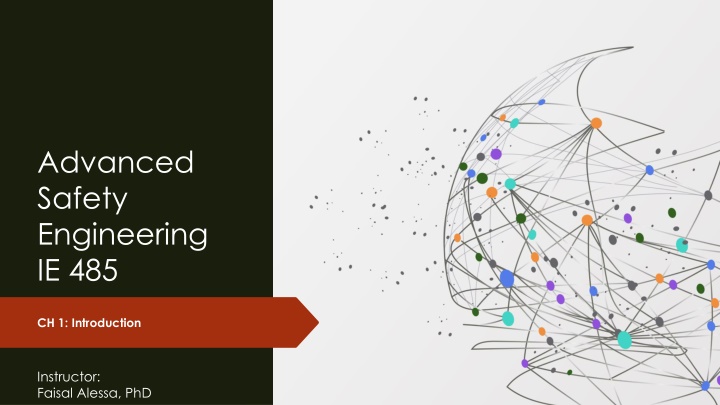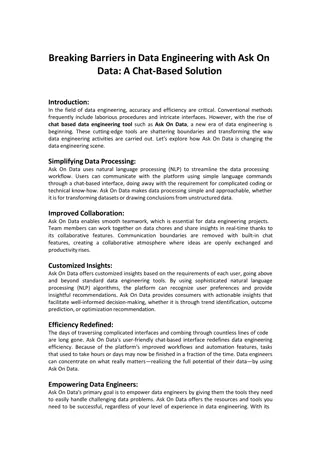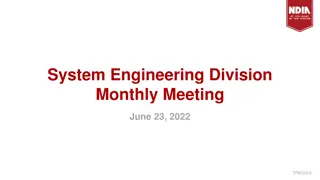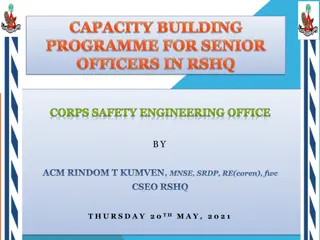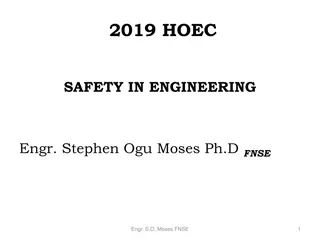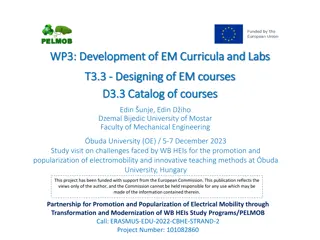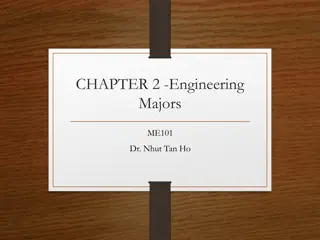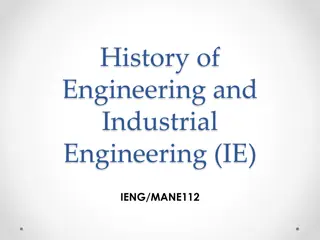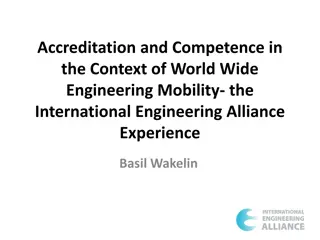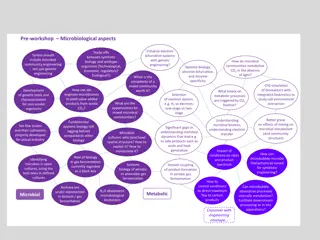Introduction to Safety Engineering
Safety engineering is crucial due to the prevalence of hazards from natural and man-made disasters, emphasizing the need for proactive risk management in the face of advancing technology and changing regulations. This field involves systematic analysis and collaboration between government and industry to ensure the safety of products and processes.
Download Presentation

Please find below an Image/Link to download the presentation.
The content on the website is provided AS IS for your information and personal use only. It may not be sold, licensed, or shared on other websites without obtaining consent from the author.If you encounter any issues during the download, it is possible that the publisher has removed the file from their server.
You are allowed to download the files provided on this website for personal or commercial use, subject to the condition that they are used lawfully. All files are the property of their respective owners.
The content on the website is provided AS IS for your information and personal use only. It may not be sold, licensed, or shared on other websites without obtaining consent from the author.
E N D
Presentation Transcript
Advanced Safety Engineering IE 485 CH 1: Introduction Instructor: Faisal Alessa, PhD
WHY DO WE NEED SAFETY ENGINEERING? 1. Hazards are every where! Natural disasters Man-made disasters Examples: An accident at a plant in Bhopal, India, in 1984, killed over 2500 people. In 2011, a Chinese high-speed train collided into another killing 38 people. In the Gulf of Mexico, worst oil spill in history, the company put aside $41 billion in 2010 to pay for damages. An earthquake caused tsunami in 2011 triggered fires and explosions at a commercial nuclear power plant in Japan, resulting in three of the six reactors melting down and over100,000 residents permanently evacuated
WHY DO WE NEED SAFETY ENGINEERING? Examples: In 1995, the Air Route Traffic Control Center, Fremont, California, lost power, causing radar screens covering Northern California, Western Nevada, and 18 million square miles of Pacific Ocean to go dark for 34 min while 70 planes were in the air, almost resulting in two separate midair collisions. A worker in downtown Chicago cut into a cable and brought down the entire Air Route Traffic Control System for thousands of square miles.
WHY DO WE NEED SAFETY ENGINEERING?
WHY DO WE NEED SAFETY ENGINEERING? Distribution of work injuries based on the result of treatment for 2019 A.D Distribution of work injuries Region Heal without a deficiency 3980 3982 604 140 5941 77 53 11 33 3 24 19 26 14893 Cure with impotence death Under treatment Total 1094 38 446 36 113 12 48 8 234 59 39 16 30 3 2 0 7 1 4 10 16 4 4 5 2 3 2039 195 . : Source: General Organization for Social Insurance (GOSI) 1940 3841 1124 653 3118 1413 144 128 46 667 131 147 68 13420 7052 8305 1853 849 9352 1545 230 141 87 684 175 175 99 30547 Al-Riyadh Makkah Al-Mokarramah Al-Madinah Al-Monawarah Al-Qaseem Eastern Region Aseer Tabouk Hail Northern Borders Jazan Najran Al-Baha Al-Jouf Total
WHY DO WE NEED SAFETY ENGINEERING? 2. Quickly advancing and changing technology New machines and processes need different regulations and considerations Business competition (less time for safety measures and testing) How do we build products with high quality, cheaply, quickly, and still safely? Forethought In advance Systematic engineering analysis Methodical approach to managing risk Government and industry collaboration
BRIEF HISTORY OF SAFETY 1877, Massachusetts passed a law to safeguard machinery. 1911, The American Society of Safety Engineers. 1913, The National Safety Council. 1930, the beginning of the implementation of accident prevention programs across the US. The system safety concept and profession started during the American military missile and nuclear programs in the 1950s and 1960s. in April 1962, System Safety Engineering: Military Specification for the Development of Air Force Ballistic Missiles was published.
WHAT IS SAFETY ANALYSIS? Safety analysis: identification of dangerous aspects of the system, and correction of them System safety engineering is a compilation of engineering analyses and management practices that control dangerous situations, specifically: Identify the hazards in a system Determine the underlying causes of those hazards Develop engineering or management controls (to eliminate hazards or mitigate consequences) Verify that the controls are adequate and in place Monitor the system and modify it as needed (continues process)
SYSTEM SAFETY AND RISK ASSESSMENT System safety is the assurance and management that the system is safe for all people, environment, and equipment. Risk assessment can be used to determine how safe something is, but it also can be used to determine the various trade-off alternatives to lower the risk in a system.
Understanding Accident Causality (Bhopal) Worst industrial accident in history ~3000 killed, 10000 permanent disabilities (including blindness), and 200,000 injured. Blamed by management on operator error Union Carbide (UC) blamed on sabotage MIC (methyl isocyanate) used in production of pesticides and polyurathanes (plastics, varnishes, and foams) Highly volatile, vapor heavier than air A major hazard is contact with water, which results in large amounts of heat. Gas burns any moist part of body (throat, eyes, lungs)
Safety Features (Bhopal) UC specified requirements to reduce hazards: MIC was to be stored in underground tanks encased in concrete Bhopal used three double-walled, stainless-steel tanks, each with a capacity of 60 tons; tanks embedded in concrete Tanks were never to contain more than half their maximum volume, or a standby tank was to be available to which some of chemical could be transferred in case of trouble. Bhopal tanks were interconnected so that MIC in one tank could be bled into another tank.
Safety Features (Bhopal) Several backup protection systems and lines of defense: Vent gas scrubber designed to neutralize any escaping gas with caustic soda. Flare tower to burn off any escaping gas missed by scrubber; toxic gases would be burned high in the air, making them harmless Small amounts of gas missed by scrubber and flare tower were to be knocked down by a water curtain that reached 40 to 50 feet above ground. Water jets could reach as high as 115 feet, but only if operated individually. In case of an uncontrolled leak, a siren was installed to warn workers and surrounding community.
Safety Features (Bhopal) MIC was to be stored in an inert atmosphere of nitrogen gas at 2 to 10 psi over atmospheric pressure. Regularly scheduled inspection and cleaning of valves specified as imperative Storage limited to 12 months maximum. If sampling, testing, or maintenance were performed at a time when there was a possibility of a leak or spill, they were to use protective rubber suits and air- breathing equipment. To limit its reactivity, MIC was to be maintained at a temperature near 0 C. Refrigeration unit provided for this purpose High temperature alarm if MIC reached 11 C.
What Happened? (Bhopal) Dec. 2, 1984, relatively new worker assigned to wash out some pipes and filters, which were clogged. Pipes being cleaned were connected to the MIC tanks by a relief valve vent header, normally closed Worker closed valve to isolate tanks, but nobody inserted required safety disk (slip blind) to back up valves in case they leaked Maintenance sheet contained no instruction to insert disk Worker assigned task did not check to see whether pipe properly isolated because said it was not his job to do so. He knew valves leaked, but safety disks were job of maintenance department.
What Happened? (Bhopal) Night shift came on duty at 11 pm. Pressure gauge was rising (10 psi instead of recommended 2 to 3 psi). But at upper end of normal range. Temperature in tank about 20 C. Both instruments were ignored because believed to be inaccurate. Operators told instead to use eye irritation as first sign of exposure. 11:30 pm: some workers noticed slight eye irritation; detected leak of liquid from an overhead line. Reported it to the MIC supervisor. Shift supervisor did not consider it urgent and postponed an investigation until after the tea break.
What Happened? (Bhopal) 12:40 am: Control room operator noticed pressure gauge was approaching 40 psi and temperature was (25 C) 12:45 am: Loud rumbling noises heard from tank. Concrete around tank cracked. Temperature in tank rose to 400 C, causing an increase in pressure that ruptured relief valve. Pressurized gas escaped in a fountain from top of vent stack and continued to escape until 2:30 am. Vent scrubber system didn t work properly. Vent flare was not operational (out of service for maintenance)
Why has It happened? (Bhopal) Chemical must be maintained at a temp less than 5 C. Refrigeration unit turned off and MIC usually stored at nearly 20 C. (Cut cost) Management adjusted threshold of alarm, accordingly, from 11 C to 20 C Practice alerts did not seem to be effective in preparing for an emergency (ran from contaminated areas and ignored buses sitting idle and ready to evacuate them) Only one worker can do pipe-washing operation should have been supervised by second shift operator, but that position had been eliminated due to cost cutting.
Why has It happened? (Bhopal) Alarms sounded so many times a week (20 to 30) that no way to know what the siren signified Emergency signal was identical to that used for other purposes, including practice drills. Not turned on until 2 hours after MIC leak started and then turned off after 5 minutes (company policy) Several Indian staff who were trained in U.S. resigned and were replaced by less experienced technicians. In 1983, chemical engineer managing MIC plant resigned because he disapproved of falling safety standards. He was replaced by an electrical engineer. Inspections and safety audits at the plant were few and superficial.
Who to blame? (Bhopal) The maintenance worker? The supervisor? Indian UC management? US UC management? Government?
Hindsight Bias After an incident Easy to see where people went wrong, what they should have done or avoided Easy to judge about missing a piece of information that turned out to be critical Easy to see what people should have seen or avoided
Hindsight Bias Almost impossible to go back and understand how world looked to somebody not having knowledge of outcome Oversimplify causality because start from outcome and reason backward Overestimate likelihood of the outcome and people s ability to foresee it because already know outcome Overrate rule or procedure violations Misjudge prominence or relevance of data presented to people at the time Match outcomes with actions that went before it: if outcome bad, actions leading to it must have been bad too (missed opportunities, bad assessments, wrong decisions, and misperceptions)
Overcoming Hindsight Bias Assume nobody comes to work to do a bad job. Assume were doing reasonable things given the complexities, dilemmas, tradeoffs, and uncertainty surrounding them. Simply finding and highlighting people s mistakes explains nothing. Saying what did not do or what should have done does not explain why they did what they did.
Overcoming Hindsight Bias Need to consider why it made sense for people to do what they did? Some factors that affect behavior Goals person pursuing at time and whether may have conflicted with each other (e.g., safety vs. efficiency, production vs. protection) Unwritten rules or norms Information availability vs. information observability Attentional demands Organizational context
Final thoughts This is why we need System Safety Forethought In advance Systematic engineering analysis Methodical approach to managing risk Government and industry collaboration - Regulations
